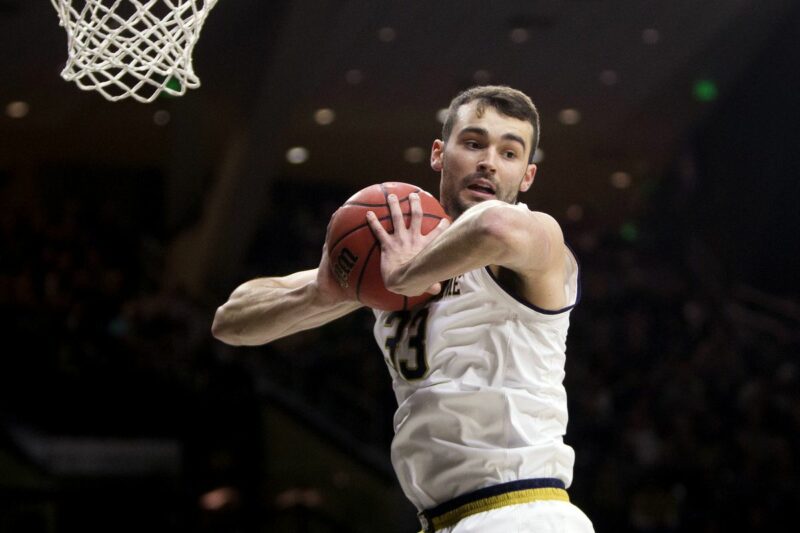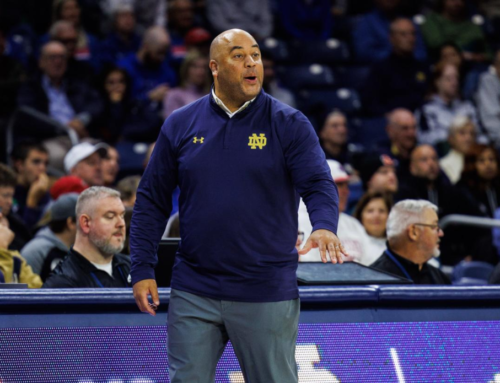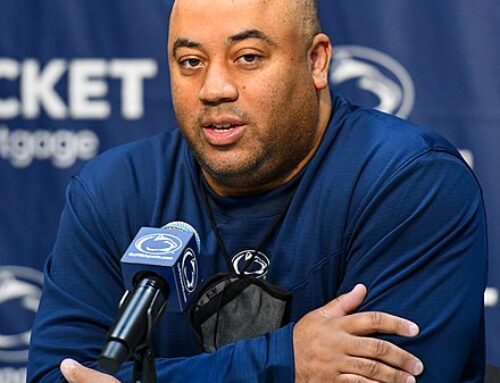With six games complete, the Notre Dame men’s hoops season is still in its very early stages. So with the obligatory small sample caveat for everything that is to follow, we do have 240 minutes’ worth of new trends and tendencies to analyze before the Irish head into the meatier portion of the nonconference schedule. All shot location data comes via barttorvik.com.
TJ Gibbs: Increasing Midrange Dependence
Let’s begin by examining TJ Gibbs’s field goal percentage by shot location.
| YEAR | AT THE RIM | MIDRANGE | 3-POINTERS |
| 2016-17 | 46% | 24% | 32% |
| 2017-18 | 49% | 34% | 40% |
| 2018-19 | 54% | 26% | 32% |
| 2019-20 | 50% | 15% | 37% |
While Gibbs has had intermittent success from deep in his career, he has been a consistently below-average shooter from within the arc. He really struggled from midrange last year, shooting a mere 26%, and that number has dropped even further this year, with Gibbs shooting only 3-20 on midrange shots. With this particular shot being a clear weakness in TJ’s game, it would be nice to see him reduce his attempts from that area, but in fact, we have seen the exact opposite happen. The following chart shows the distribution of Gibbs field goal attempts by location:
| YEAR | AT THE RIM | MIDRANGE | 3-POINTERS |
| 2016-17 | 46% | 15% | 39% |
| 2017-18 | 29% | 22% | 49% |
| 2018-19 | 20% | 27% | 53% |
| 2019-20 | 18% | 30% | 52% |
As Gibbs’s midrange efficiency has continued to decrease, he is actually attempting more of those shots now than ever before. Gibbs has almost completely sacrificed shots at the rim, which were his most frequent shot type as a freshman. This has been detrimental in multiple ways. Beyond the obvious fact that Gibbs is settling for lower-percentage attempts, this lack of attacking impetus has also directly impacted his free throw rate.
| YEAR | FREE THROW RATE |
| 2016-17 | 43.4 |
| 2017-18 | 36.7 |
| 2018-19 | 28.9 |
| 2019-20 | 26.9 |
Free throw shooting has essentially been the one area that Gibbs has been consistently effective at throughout his Irish career, yet his increased dependence on jump shooting has caused his free throw rate to decrease every year.
Gibbs has been a frustratingly inconsistent player throughout much of the last two seasons after he put up some pretty remarkable numbers as a sophomore guard. While he may never recapture the shooting form he had that season, he can certainly attempt to skew his shot profile towards lay-ups and 3s, minimizing the inefficient pull-ups he has fallen in love with.
Dane Goodwin: Improvement All Around
| YEAR | AT THE RIM | MIDRANGE | 3-POINTERS |
| 2018-19 | 59% | 25% | 34% |
| 2019-20 | 83% | 47% | 39% |
Dane Goodwin has been one of the most improved Irish players this year, shooting better from every location on the court while taking on more offensive responsibility. His game-saving hot streak in the second half of the Toledo game certainly did a lot to boost these numbers, but it’s worth noting that Goodwin leads the Irish’s main 8-man rotation at FG% at the rim and 3P%, and he only trails Robby Carmody (who is 3 for 5) in midrange FG%.
Mike Brey has talked a lot about Goodwin needing to play with a bit more edge and aggression, and his role as the go-to guy in that Toledo 2nd half should only help his confidence. The Irish have also put Goodwin in the post far more than last season, and he has shown the ability to get some good looks with nifty ball fakes and footwork. While it’s probably too much to ask for Goodwin to shoot at an elite clip throughout the season, even decent shooting numbers would be desperately appreciated by this roster. If Goodwin maintains anything close to his current splits, he should be a member of the Irish closing 5 in tight games.
Prentiss Hubb: Not Attacking Enough
2018-2019 Free Throw Rate: 17.7
2019-2020 Free Throw Rate: 6.3
After what looked like a breakout performance in the season opener at UNC, Prentiss Hubb has cooled off considerably, culminating in a benching down the stretch against Toledo. It has often seemed in his early career that Hubb takes his foot off the gas against inferior opponents, and the Irish simply don’t have enough weapons to consistently get away with that.
One area that I’d like to see Hubb work on is playing more downhill. For the second consecutive season, more than half of Hubb’s field goal attempts are coming from beyond the arc. Brey has expressed confidence in Hubb letting it fly when he gets open looks, but Hubb’s strengths as a player really seem to be his ability to penetrate the defense and finish creatively around the rim. Far too often, the Irish fall into a pattern of handoffs around the 3-point arc, without anyone really probing opposing defenses. Hubb has perhaps the greatest ability of any Irish guard to break this pattern, yet he often seems to drift into complacency.
Hubb has attempted a mere 4 free throws through 6 games, which is pretty horrendous. Similarly to Gibbs, he just isn’t getting to the rim very much at all. Take a look at Hubb’s career distribution of FGA by distance compared to some recent Irish PGs.
| PLAYER | AT THE RIM | MIDRANGE | 3-POINTERS |
| Prentiss Hubb | 26% | 18% | 56% |
| Matt Farrell | 25% | 18% | 57% |
| Demetrius Jackson | 38% | 23% | 39% |
| Jerian Grant | 31% | 28% | 41% |
Hubb’s shot profile is almost exactly the same as Matt Farrell’s, one of the better-shooting Irish guards in recent memory. While Jackson and Grant are both lofty comparisons, they were both guards who constantly distorted the defense by driving the ball. As Hubb continues to develop, I would love for his shot selection to drift closer to the Jackson/Grant prototype than the Farrell 3-point heavy approach.
Nate Laszewski: Playing Like a Big
2018-2019 Defensive Rebounding %: 14.3
2019-2020 Defensive Rebounding %: 21.0
Nate Laszewski’s usefulness to this Irish team will always rest largely on his ability to convert his 3-point attempts, and there’s no sugarcoating the fact that he has been disappointing in that area. One area in which we can celebrate progress is Laz’s improved big man skills.
Laszewski clearly came into Notre Dame as a skinny kid who needed to put on some muscle to compete down low with ACC competition. In his second year, we are already seeing some progress, with Laz’s defensive rebounding rate up by almost 50% from last year. Last year, he was rebounding at approximately the same rate as wings DJ Harvey and Nik Djogo. This year, his numbers are closer to John Mooney and Juwan Durham than the rest of the roster.
Laz has also done more work down low on the offensive side of the game. He has already dunked 4 times this year after throwing down 5 all of last season, and he has increased his percentage of field goal attempts at the rim from 20% to 33%. All of this is secondary to his ability to fulfill his promise as a knockdown shooter, but flashes of multi-dimensional contribution have been nice to see in the meantime.
Quick Hits
Juwan Durham
2018-2019 Fouls Committed/40: 5.6
2019-2020 Fouls Committed/40: 2.2
Durham had two clear obstacles preventing him from being a key contributor last season: injury problems and foul trouble. Fortunately there haven’t been any setbacks on the injury front, and Durham has shown nice early returns in cutting back on fouls. His foul rate is down more than 50% from last season, and he has been able to maintain an elite block rate of 12.8%. With any luck, Durham will continue to develop with consistent minutes throughout the season and anchor the much-improved Irish defense.
John Mooney
2017-2018 FT%: 55
2018-2019 FT%: 77
2019-2020 FT%: 42
It’s been a weird start to John Mooney’s senior season. After a slow start against UNC, Mooney heated up against some of the cupcake opponents, winning ACC player of the week after a career high in points against Marshall. The stomach flu sidelined him against Presbyterian, and he could not buy a bucket in his return against Toledo. Most concerning to me has been the apparent regression in Mooney’s free throw shooting. The charity stripe was a clear weakness in Mooney’s game as an underclassman, but he remarkably turned that into a strength last season. This year, his attempts from the line have looked ugly once again, almost costing the Irish the game against Toledo. Mooney has always been an enigmatic player as a strong shooter despite the hitch in his shot, and it is starting to seem possible that his free throw form will end up as a recurring Achilles heel this season.
Rex Pflueger
2018-2019 Steal%: 3.4
2019-2020 Steal%: 4.2
As a program, Notre Dame basketball has a very distinct profile when it comes to turnovers. They rarely ever commit them, regularly placing in the top-10 nationally in least turnovers committed. On defense, they rarely force them, instead opting to keep fouls low. This year has been different, with the Irish forcing turnovers on 23% of opponents’ possessions, their highest mark in over a decade. The leader in these forced turnovers has been Rex Pflueger, who has long been tasked with guarding the opposition’s best player. Pflueger has shown clear physical rustiness in his return from a torn ACL, and he remains a fairly low-impact offensive player, but his defense remains as solid as ever. He made some extremely clutch defensive plays against Toledo, and his all-out effort in big moments will likely keep him in the Irish closing lineups for the foreseeable future.
Robby Carmody
2018-19 Free Throw Rate: 38.2%
2019-20 Free Throw Rate: 52.4%
Lastly, we have Robby Carmody, whose extreme downhill style of play can be seen in his very high 52% free throw rate, which coincidentally matches the 52% of his field goal attempts that have come at the rim. Carmody has done a very good job at being just crafty enough to avoid head-on collisions when he drives the ball, drawing more fouls and committing fewer turnovers than he did in limited minutes before his season-ending injury last season. His distinct mindset definitely provides the Irish an intriguing weapon off the bench, but Mike Brey has expressed reticence to overuse Carmody, especially after a blow to the head sustained against Marshall placed him in the concussion protocol. This will probably be a persistent battle for Carmody, as he attempts to toe the line between an aggressive, contact-heavy style of play and remaining healthy.




Great, great stuff here, Paddy.
We have GOT to get the ball to the rim more on offense. TJ is too strong and well-built and Hubb is too athletic not to. Far lesser athletes are able to do it with decent consistency, and it seems to be an attitude thing more than anything. Brey needs to challenge their, ahem, manhood a little bit in this area, hopefully starting tonight with an opponent where they should be able to do this relatively easily.
This also extends to Mooney and Durham. We need to get back into more of a pick-and-roll offense and just attack, attack, attack the rim off it. Don’t think so much and force quick decisions from defenders and dare them to stay in front of both of you.
It’s just all been a little lazy so far, which is unacceptable when you can’t shoot. I know they have a “regression to the mean” attitude right now, which to some extent is good, but they need to face reality, too. It ain’t working, and it’s past time to start attacking the basket more with fearlessness and aggressiveness. What do you really have to lose, right? I do think the shooting will come, but it’s much more likely to come when you start getting more downhill action anyway.
I’m truly fascinated by next week against Maryland and BC. Truly nothing would surprise me. There’s real potential that this team can really develop into something, but there’s also real potential for things to stagnate and we’re looking at only a marginal improvement from last year. Need to gets things revved up in a hurry. It starts with Hubb!
I would love for Brey to just feed Hubb game tape of Jerian Grant. Their body types aren’t very similar, so it might seem counter-intuitive, but I think Hubb can be that exact same type of player for this team. Get into the paint for a shot, kick to Goodwin (Vasturia) in the corners, or hit a slashing Carmody (Connaughton). I think he really has the ability to be a great PG in this league; he just needs more time, and perhaps a slightly better understanding of the intricacies of Brey’s system.
This is really tremendous analysis. Better than anything I’ve ever seen on the pay sites, to be honest.